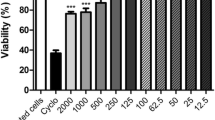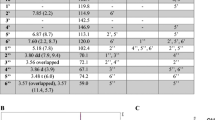Abstract
Ochratoxin A (OA) has been reported to affect immune function both at the level of antibody synthesis and natural killer (NK) cell activity. In the present study we demonstrate that exposure of purified human lymphocyte populations and subpopulations to the toxin will abrogate the cells' ability to respond to activating stimuliin vitro. Thus, both IL-2 production and IL-2 receptor expression of activated T lymphocytes are severely impaired. When the cells are preincubated with the analogue ochratoxin B (OB) prior to OA exposure, the inhibitory effect of OA is reversed. Furthermore, the inhibitory effect of OA on antibody production is not only due to blocking of T helper cell function. Highly purified B lymphocytes will not respond to polyclonal activatorsin vitro after a brief pulse with OA. The results strongly suggest that the toxin causes its immunosuppression through interference with essential processes in cell metabolism irrespective of lymphocyte population or subpopulation.
Similar content being viewed by others
References
Bendele SA, Carlton WW, Krogh P, Lillehoj EB. Ochratoxin A carcinogenesis in mouse. Abstr. 3rd Mycological Congress, Tokyo 1983; 21.
Bøyum A. Isolation of lymphocytes, granulocytes and macrophages. Scand J Immunol 1976; 5 (suppl. 5): 9–15.
Cooray R. Effects of some mycotoxins om mitogeninduced blastogenesis and SCe frequency in human lymphocytes. Fd Chem Toxic 1984; 7: 529–34.
Creppy EE, Kern D, Steyn PS, Vleggaar R, Røschenthaler R, Dirheimer G. Comparative study of the effect of ochratoxin A analogues on yeast aminoacyltRNA synthetases and on the growth and protein synthesis on hepatoma cells. Toxicol Letters 1983; 19: 217–24.
Creppy EE, Stømter FC, Kern D, Røschenthaler R, Dirheimer G. Effects of ochratoxin A metabolites on yeast phenyl-alanyl-tRNA synthetase and on the growth and in vivo protein synthesis of hepatoma cells. Chem-Biol Interact 1983; 47: 239–47.
Creppy EE, Størmer FC, Røschenthaler R, Dirheimer G. Effects of two metabolites of ochratoxin A, (4R)-4-hydroxyochratoxin A and ochratoxin, on immune response in mice. Infect Immun 1983; 39: 1015–1018.
Dresser DW. Immunization of experimental animals. In Handbook of experimental immunology vol A. Ed. M. Weir 1986. Blackwell Scientific Publications.
Elling F, Nielsen JP, Lillehoj EB, Thomassen MS, Størmer FC. Ochratoxin A induced porcine nephropathy: enzyme and ultrastructure changes after short term exposure. Toxicon 1985; 23: 247–54.
Frøland SS, Natvig JB. Identification of three different human lymphocytes population by surface markers. Transplant. Revs.. 1976; 16: 114–32.
Hansen CE, Dueland S, Drevon CA, Størmer FC. Metabolism of ochratoxin A by primary cultures of rat hepatocytes. Appl Environ Microbiol 1982; 43: 1267–71.
Kanisawa M. Carcinogenicity of ochratoxin A and citrinin. Abstr. 3rd Mycological congress Tokyo 1983; 21.
Kanisawa M, Suzuki S. Introduction of renal and hepatic tumors in mice by ochratoxin A, a mycotoxin. Gann 1978; 69: 599–600.
Krogh P, Hald B, Pedersen EJ. Occurrence of ochratoxin A and citrinin in cereals associated with mycotoxic porcine nephropathy. Acta Microbiol Scand Sect B.81. 1973; 81: 689–95.
Lea T, Smeland E, Funderud S, Vartdal F, Davies C, Beiske K, Ugelstad J. Characterization of human mononuclear cells after positive selection with immunomagnetic particles. Scand J Immunol 1986; 23: 509–19.
Lea T, Vartdal F, Davies C, Ugelstad. Magnetic monosized polymer particles for fast and specific fractionation of human mononuclear cells. Scand J Immunol 1985; 22: 207–16.
Luster MI, Germolec DR, Burleson GR, Jameson CW, Ackermann MF, Lamm KR, Hayes HT. Selective immunosuppression in mice of natural killer cell activity by ochratoxin A. Cancer Res 1987; 47: 2259–63.
Pier AC, Fichtner, Cysenski SJ. Effect of aflatoxin on the cellular immune system. Ann Nutr Aliment 1977; 781–8.
Støren O, Holm H, Størmer FC. Metabolism of ochratoxin A by rats. Appl Environ Microbiol 1982; 44: 785–9.
Størmer FC, Hansen CE, Pedersen JI, Hvistendahl G, Aasen AJ. Formation of (4R)- and (4S)-4-hydroxyochratoxin A from ochratoxin A by rabbit liver microsomes. Appl Environ Microbiol 1983; 45: 1183–7.
Størmer FC, Kolsaker P, Holm H, Rogstad S, Elling F. Metabolism of ochratoxin B and its possible effects upon the metabolism and toxicity of ochratoxin in rats. Appl Environ Microbiol 1985; 49: 1108–12.
Størmer FC, Pedersen JI. Formation of 4-hydroxyochratoxin A from ochratoxin A by rat liver microsomes. Appl Environ Microbiol 1980; 39: 971–5.
Størmer FC, Støren O, Hansen CE, Pedersen JI, Aasen AJ. Formation of (4R)- and (4S)-4-hydroxyochratoxin A and 10-hydroxyochratoxin A from ochratoxin A by rabbit liver microsomes. Appl Environ Microbiol 1983; 45: 1183–7.
Author information
Authors and Affiliations
Rights and permissions
About this article
Cite this article
Lea, T., Steien, K. & Størmer, F.C. Mechanism of ochratoxin A-induced immunosuppression. Mycopathologia 107, 153–159 (1989). https://doi.org/10.1007/BF00707553
Issue Date:
DOI: https://doi.org/10.1007/BF00707553




